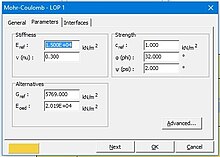Plaxis
 Input parameters given for the Mohr–Coulomb soil model | |
| Developer(s) | Bentley Systems |
|---|---|
| Initial release | December 1982 |
| Stable release | CONNECT Edition V20.1 (2D & 3D)
|
| Operating system | Windows |
| Available in | English, Chinese, Japanese |
| Type | Computer-aided design, Finite Element Analysis |
| License | Floating licensing |
| Website | bentley |
Plaxis (sometimes stylised in all caps; Plane strain and axial symmetry, indicating the geometric types handled in the original code[1]) is a computer program that performs finite element analyses (FEA) within the realm of geotechnical engineering, including deformation, stability and water flow.[2] The input procedures enable the enhanced output facilities provide a detailed presentation of computational results. PLAXIS enables new users to work with the package after only a few hours of training.
Plaxis BV was acquired by the American Bentley Systems, Inc. in 2018.[3]
Calculation features
Interfaces
Interfaces[4][5][6] these are surfaces along which partial or complete slip of a structure can be simulated using the interaction coefficient, the ratio of friction "soil on soil" to "soil structure" . If the interfaces are not marked, the situation of soil destruction is simulated. Recommendation according to Eurocode 0.67. If the resistance parameter Strenght is set as Rigid (rigid), this means that there is no separation between the two media and automatically. There is no point in changing the interface in linear models (foundation) ( is the coefficient by which we multiply phi and c, which is taken from the nearest soil to reduce contact friction between two different materials). Since there is no strength in the linear model, there is nothing to lower (you can assign in the Mohr-Coulomb model for the foundation ).
An interface is a final element (sonlu eleman) that is responsible for interface elements. Interfaces reduce fi and c near the ground are reduced. Without them, the contact between the pile and the surrounding soil will be absolutely rigid. The soil will remain in one place, the pile will move away. If there are no interfaces, we will supply the soil and the pile will work together. Stress relaxation (when after a week the pile has rested and it is calmly finished off), excess pore pressure will resolve and the pile can be finished off. Viscous soils are modeled by an interface where the phase interface is set to 0.01.
Text is available under the CC BY-SA 4.0 license; additional terms may apply.
Images, videos and audio are available under their respective licenses.



